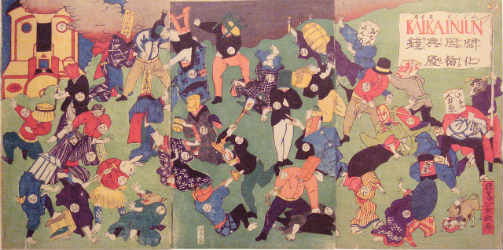
On February 3rd, 1968, Meiji ascended to the Chrysanthemum Throne. This was a period in which Japan lagged behind the West militarily. The Samurai Class remained strong and often unruly. The Shogunate was in place but wavering in power. Meiji taking the throne was the catalyst for rapid change. It restored Imperial rule to Japan. Within years the Shogunate was ended, the Samurai integrated into a Westernised system and government transformed. This was the beginning of Modern Day Japan.
Togugawa Shogunate
Before Meiji, Japan was ruled by the Togugawa Shogunate. Government was based a a feudal system with the Shogun at it’s head. There was an Emperor but they held little political power and were often left isolated in their palace. Under the Shogunate land was held by vassals. In return for their inherited land they provided service to the Shogun. The vassals, military men, governed from Edo Castle. While in their own lands they left hostages at Edo Castle as a security bond. Thus they ran the country and the provinces on a system based on military service and taxation in return for their lands. These vassals were the famous Samurai class.
Samurai
The Samurai were a huge part of feudal Japanese Society. They were military men but also governed. They had a lot of power as a result of their service to the Shogun. Just before Meiji ascended the throne, their status was threatened. From 1853 the Shogunate had started to change policy. It was more open to foreign trade and was willing to reform government systems. The feudal era and rule from Edo were coming to an end. The formal end of the Tokugawa Shogunate was in November, 1867. There then followed a transition toward an Imperial Government, though this had not been concluded until Meiji took the throne.
Boshin War
The Samurai reaction to the the changes over the period 1853-1868 was mixed. Members of the Satsuma Clan rose in revolt. In January, 1868, the Boshin War (War of the Year of the Dragon) began. Samurai of the Satsuma Clan fought Imperial Forces. The Imperial Army was trained in the use of western weapons. It contained many Samurai who had left the Feudal structure and moved into more modern, and equally important, roles.
By early 1869 the major daimyō (Feudal Samurai Lords) had been persuaded to return to their homes. They submitted to the Emperor. Imperial Rule was secured. Following this the systems and structure of Government in Japan changed. Western ideas were taken on board. New technology was adopted. The Samurai class was ended. The 1.9 million Samurai integrated into the new structures. Military reform created a new style of leadership. Land reform changed ownership, rights and efficiency.
The Meiji Ascension was the start of the restoration of Imperial Rule in Japan.
Leave a Reply
You must be logged in to post a comment.